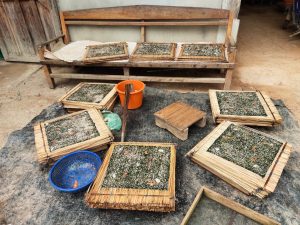Sabaidee! My name is Emmi Kaislasalmi, and I am a master´s student in forest ecology at the University of Helsinki. Earlier this year I got the HiLIFE Conference Grant to participate in a three-week intensive field course in Laos called “Tropical Forests and Agroforests”.
Here in this post, I am going to share my experience of the course. Please note that this course is conducted every second year (next time in January 2025), and you might have the chance to also get in if you want to learn more about tropical forests, the problems facing them, and the deep interconnection between forest well-being with societal and economic aspects.
Multicultural experience
The course was conducted by the University of Helsinki in partnership with a local university, Souphanouvong University from Luang Prabang. The course participants, students, and professors were from Finland, Laos, and Thailand.
We started from a UNESCO World Heritage City, Luang Prabang, where we got straight away immersed in the Lao culture as we arrived. Throughout the course, we learned about each other’s cultures and customs as we worked in groups of four, where the participants were at least from three different nationalities. Learning from one another was one of the greatest experiences for me.
On the second day, we headed to Nambak District, famous for its crispy river weed, “kaipen”, which is a delicacy we enjoyed throughout the course.

Hands-on approach and field research
After a short lecture and introduction on what we were about to do, we left to the field to conduct research. The research had two major parts, one was doing biodiversity research and forest inventory in the tropical forests and agroforests, and the other part was interviewing the locals and trying to understand their relationship with forest and forest products in terms of livelihood and food security in the Nambak District.

In the forest, we learned to use different biodiversity and forest inventory methodologies, identify different tree and herbaceous species, find the indicators for forest disturbance, and how extremely diverse and beautiful the forests in Laos can be. We also learned that some trees make you itchy if you stand underneath them, some smell like cinnamon, and others bleed red sap, that looks like blood, if make a cut on the trunk.
By conducting the interviews, we learned about locals´ perceptions and needs when it comes to forests and forest products. Especially in the more remote villages, where access to stores and markets is not easy, people rely on non-timber forest products (NTFPs) such as bamboo, different wild vegetables and herbs, mushrooms, and bushmeat for sustenance and livelihoods. Firewood is also an everyday necessity for the locals, as cooking is done with using firewood. When building or renovating a house, the timber usually comes from the local community forests, which are cared and managed by the whole community.
What I left the course with
What I truly loved about the experience was that we did not only learn about the ecological and environmental aspects of tropical forests. Instead, the course had an interdisciplinary approach, and we learned about the social and economic realities that affect tropical forests, and how understanding and addressing these issues is key to sustainable forest and land-use management.
Looking ahead, I am convinced that we should have more courses and collaboration between disciplines and departments to address many of the current challenges regarding sustainable development and land-use. This approach is essential to bridge the divide between our current understanding of forests—focusing on their ecological and environmental dimensions—and the broader knowledge we should possess about societal, economic, governmental, and legislative aspects.
This interdisciplinary approach is needed to bring long-term solutions to the many problems facing tropical forests, including the loss of biodiversity, forest degradation, and deforestation. Moreover, it would also address the needs of the local communities and enhance their overall well-being.
Participating in this course was a truly enriching experience, and I am very grateful to HiLIFE for awarding me the HiLIFE Conference Grant since it made the experience accessible to me. My time in Laos was also very meaningful to me because I got insights about the direction in which I want to pursue my future career.
This field course in Laos was an unforgettable journey that deepened my appreciation for tropical forests and the critical importance of their preservation. The experiential learning, combined with theoretical insights and interactions with experts and local communities, enriched my understanding of ecology, research methodologies, and how the welfare of local communities plays a vital role in ensuring the health and prosperity of forests.
